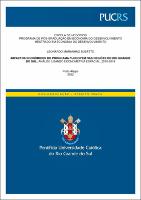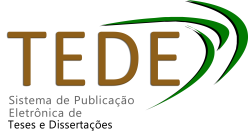| Share record |


|
Please use this identifier to cite or link to this item:
https://tede2.pucrs.br/tede2/handle/tede/10570Full metadata record
| DC Field | Value | Language |
|---|---|---|
| dc.creator | Busatto, Leonardo Maranhão | - |
| dc.contributor.advisor1 | Fochezatto, Adelar | - |
| dc.contributor.advisor1Lattes | http://lattes.cnpq.br/5935973885331465 | por |
| dc.date.accessioned | 2022-12-01T18:07:29Z | - |
| dc.date.issued | 2022-08-31 | - |
| dc.identifier.uri | https://tede2.pucrs.br/tede2/handle/tede/10570 | - |
| dc.description.resumo | A presente dissertação é constituída de uma avaliação dos impactos econômicos gerados pelo principal programa de incentivo fiscal do estado do Rio Grande do Sul (RS) – o Fundopem. Utilizando-se de dados de dez anos do programa, entre 2010 e 2019, o presente trabalho procurou analisar os efeitos dos investimentos incentivados pelo programa na economia das regiões do RS, considerando o seu componente espacial. Para tanto, foi realizada uma Análise Exploratória de Dados Espaciais (AEDE) e, a partir da constatação da existência de correlação espacial entre as variáveis utilizadas, a construção de um modelo de econometria espacial utilizando variáveis instrumentais para mensurar os efeitos associados entre os investimentos incentivados pelo programa e as variáveis endógenas, Valor Adicionado Bruto (VAB) Industrial e taxa de emprego na indústria. A partir das análises espaciais, foi possível comprovar que as variáveis endógenas possuem autocorrelação espacial e que essas mesmas possuem correlação espacial com as variáveis explicativas, especialmente relacionadas ao Fundopem. Entretanto, os resultados obtidos pelo modelo econométrico não permitiram comprovar que a realização de investimentos a partir do programa gerou efeitos econômicos nos municípios em que foram realizados. Por outro lado, ao incluir uma variável correspondente ao programa Fundopem defasada espacialmente, verificou-se que a realização de investimentos a partir do programa em determinado município afeta o VAB industrial dos municípios vizinhos, gerando um efeito “transbordamento” na região. | por |
| dc.description.abstract | This dissertation consists of an evaluation of the economic impacts generated by the main tax incentive program in the state of Rio Grande do Sul (RS) – Fundopem. Using data from ten years of the program, between 2010 and 2019, the present work sought to analyze the effects of the investments encouraged by the program on the economy of the regions of RS, considering its spatial component. Therefore, an Exploratory Spatial Data Analysis (ESDA) was carried out and, based on the existence of a spatial correlation between the variables, the development of a spatial econometric model using instrumental variables to measure the associated effects between the incentivized investments by the program and the endogenous variables, Industrial Gross Value Added (GVA) and employment rate in industry. Based on the spatial analyses, it was possible to prove that the endogenous variables have spatial autocorrelation and that they have a spatial correlation with the explanatory variables, especially those related to Fundopem. However, the results obtained by the econometric model did not allow to prove that the fulfilment of investments from the program caused economic effects in the municipalities where they were carried out. On the other hand, by including a variable corresponding to a spatially lagged variable of Fundopem program, it was confirmed that doing investments from the program in each municipality affects the industrial GVA of neighboring municipalities, generating an “overflow” effect in the region. | eng |
| dc.description.provenance | Submitted by PPG Economia do desenvolvimento ([email protected]) on 2022-11-25T15:55:42Z No. of bitstreams: 1 LEONARDO_MARANHÃO_BUSATTO_DIS.pdf: 1361302 bytes, checksum: fe46286f31160af57666fc30de7ea754 (MD5) | eng |
| dc.description.provenance | Approved for entry into archive by Sheila Dias ([email protected]) on 2022-12-01T17:55:48Z (GMT) No. of bitstreams: 1 LEONARDO_MARANHÃO_BUSATTO_DIS.pdf: 1361302 bytes, checksum: fe46286f31160af57666fc30de7ea754 (MD5) | eng |
| dc.description.provenance | Made available in DSpace on 2022-12-01T18:07:29Z (GMT). No. of bitstreams: 1 LEONARDO_MARANHÃO_BUSATTO_DIS.pdf: 1361302 bytes, checksum: fe46286f31160af57666fc30de7ea754 (MD5) Previous issue date: 2022-08-31 | eng |
| dc.format | application/pdf | * |
| dc.thumbnail.url | https://tede2.pucrs.br/tede2/retrieve/186079/LEONARDO_MARANH%c3%83O_BUSATTO_DIS.pdf.jpg | * |
| dc.language | por | por |
| dc.publisher | Pontifícia Universidade Católica do Rio Grande do Sul | por |
| dc.publisher.department | Escola de Negócios | por |
| dc.publisher.country | Brasil | por |
| dc.publisher.initials | PUCRS | por |
| dc.publisher.program | Programa de Pós-Graduação em Economia do Desenvolvimento | por |
| dc.rights | Acesso Aberto | por |
| dc.subject | Análise Espacial | por |
| dc.subject | Fundopem | por |
| dc.subject | Benefícios Fiscais | por |
| dc.subject | Rio Grande do Sul | por |
| dc.subject.cnpq | CIENCIAS SOCIAIS APLICADAS::ECONOMIA | por |
| dc.title | Impactos econômicos do programa Fundopem nas regiões do Rio Grande do Sul : análise usando econometria espacial, 2010-2019 | por |
| dc.type | Dissertação | por |
| dc.restricao.situacao | Trabalho não apresenta restrição para publicação | por |
| Appears in Collections: | Programa de Pós-Graduação em Economia do Desenvolvimento | |
Files in This Item:
| File | Description | Size | Format | |
|---|---|---|---|---|
| LEONARDO_MARANHÃO_BUSATTO_DIS.pdf | LEONARDO_MARANHAO_BUSATTO_DIS | 1.33 MB | Adobe PDF |  Download/Open Preview |
Items in DSpace are protected by copyright, with all rights reserved, unless otherwise indicated.




